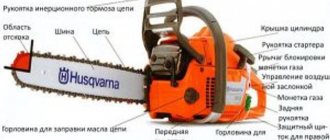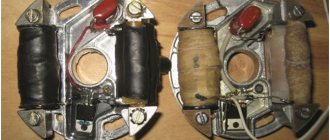A separate class of chain saws uses gasoline engines as a power unit. They are necessarily equipped with an ignition system, which is responsible for the timely ignition of the air-fuel mixture in the cylinders through an electric discharge that breaks through the space between the electrodes of the spark plugs. The correct operation of the motor depends on the moment at which the spark occurs. Particular attention should be paid to checking the technical condition of the ignition system of a purchased gasoline saw. In specialized stores, the equipment is sold in working order, but if the setting turns out to be wrong, you can set the ignition on the chainsaw yourself.
How the chainsaw ignition works and how it works
The design of a carburetor engine does not depend on the model of the tool. Therefore, we can talk about a standard chainsaw ignition system. It consists of the following elements:
- Magneto. Is an alternating current generator. Necessary to supply the spark plug with electric current. Externally, this part looks like a stationary winding of an inductor and a permanent magnet, which is fixed on the flywheel. The latter rotates simultaneously with the engine crankshaft.
- Spark plug.
- An electrical cable that connects the 2 previous elements.
- Buttons to turn off the device.
The chainsaw ignition circuit is simple. After the tool starts, a rotating magnetic field is formed due to the movement of the flywheel and crankshaft. It creates a moving force in the existing winding, which is transformed into voltage. This potential is enough to form a spark.
The only difference between different chainsaw models may be whether a contact or non-contact magneto is used. In the first case, one winding lead goes to the spark plug, and the second goes first to the shutdown button, and then through it to the ground. In the second case, the device contains a capacitor, which, when discharged, generates a current.
Selection by models
- Chainsaws
- Spare parts for Chinese chainsaws 45, 52 cc
- Spare parts for Chinese chainsaws 38 cc
- Spare parts for Chinese chainsaws 25 cc
- Spare parts for Chinese Shtil 660
- Spare parts for Partner 350, 351, 352, 371
- Spare parts for Partner 340S, 350S, 360S
- Spare parts for Husqvarna 137, 142
- Spare parts for Husqvarna 230, 235, 236, 240
- Spare parts for Husqvarna 365, 372
- Spare parts for Shtil 180
- Spare parts for Shtil 210, 230, 250
- Spare parts for Shtil 290
- Spare parts for Shtil 361
- Trimmers
- Spare parts for Chinese trimmer 33, 43, 52 cc
- Spare parts for Chinese trimmer 26 cc
- Spare parts for Husqvarna 125, 128
- Spare parts for Favorit T283, T284
Basic malfunctions and their elimination
If you cannot start the saw the first time, there may be several reasons. Most often the problem is related to the spark plug:
- wear of the electrode or damage to the ceramic insulator;
- loose fit of the removable cap (if any);
- sparks flying along the ceramic winding, a sign of which is a brown residue on the outer shell;
- cracks in the spark plug cap (a saw with this problem will continue to work, but may cause pain to the user when touched).
If no problems were found with the spark plug, it is recommended to inspect the wires coming from the coil. They may be torn or have other mechanical damage. Wire breaks inside the insulation are possible, so sometimes these violations cannot be detected by visual inspection.
The cause of the breakdown may lie in the shutdown switches. It's easy to check them. To do this, you need to disconnect the wires from the module and then check the ignition. If a spark appears after switching off, the switch must be replaced.
Structural components
All engines, be it a car or another internal combustion engine tool, have similar operating principles.
It is no exception that there are such outstanding chainsaws and are used with pleasure by such consumers as Goodluck, Calm or Husqvarna.
Drive into them. This is all familiar, respectively, the fuel tank, the engine and the working part, which does the work itself, as well as other articulated parts that help with control.
Sometimes, during operation, some problems may arise in this fairly reliable tool, such as a chainsaw.
All engines, be it a car or another instrument using a gasoline engine, have similar operating mechanisms.
Not an exception are such famous chainsaws, which are used with pleasure by consumers, such as Goodluck, Shtil or Husqvarna.
The drive in them is the familiar internal combustion engine, respectively the fuel tank, the engine and the working element that directly performs the work, as well as other attachments that help with control.
Sometimes during operation some problems may arise with this fairly reliable tool like a chainsaw.
Check the ignition coil on a chainsaw
If preliminary actions did not help in identifying the cause of the chainsaw malfunction, then it is necessary to check the ignition coil of the saw. Diagnostics is performed in several stages:
- Measure the coil resistance using a multimeter. To do this, you should know the optimal parameters, which are indicated in the operating instructions. However, due to the use of semiconductor elements in the system, if you try to “ring” the coil, the result will be an “Open Circuit” reading. This is fine. A sign of a malfunction is a positive test result. That is, if it was possible to determine the resistance of the coil using a special tool, then it is definitely faulty.
- Check for spark with a special device. This device should be installed in the open circuit located between the spark plug and the high-voltage terminal of the saw's ignition coil. The indicators will be visible on the display. This verification method is more often used in service centers, since the device required for this is expensive, and the costs will not be comparable to the benefits provided.
- Testing the coil using a spark plug, i.e. perform a homemade ignition. To do this, you need to unscrew it, and then attach the body to the cylinder. Now you need to pull the starter and watch for a spark. But this method only gives an approximate result, since the flywheel spins faster due to the unnatural position of the spark plug.
If none of these methods work, or if you need to check in the field, you can proceed as follows:
- Remove the cap from the candle, insert a nail without a head into the core at a distance of 6-7 mm from the cylinder. This must be done as carefully as possible so as not to damage the part.
- Perform the steps required to wind the tool. Now you need to look at the presence of a spark and its color. If there is no malfunction, the spark will be strong and the color will be bright blue.
This method can be used as a last resort and only if there are no electronic components, but it is important to follow the rules:
- Do not completely unscrew the spark plug, as this may cause the flywheel to rotate faster, which is not the correct engine operating mode;
- it must be located at a distance that corresponds to the compression model and dielectric properties of the fuel mixture, so this parameter can be found in the instructions (the value of 6-7 mm is average).
Algorithm for determining the causes of poor mixture formation
In any case, a wet spark plug on a chainsaw indicates a clear imbalance in the composition of the air-fuel emulsion.
Already at a fuel to air ratio of 1:14, the conditions for spark formation worsen; the lack of air prevents the normal combustion of the fuel-air emulsion compressed in the combustion chamber. Why does a chainsaw have trouble starting?
- Presence of a spark between the electrodes of the spark plug;
- Gap between the ignition module and the flywheel with a magnet;
- Condition of fuel and air filters;
- Supply of fuel mixture;
- Correct carburetor settings;
- Breather (small hole) of the fuel tank cap;
- Performance of the exhaust system.
Optimal chainsaw spark plug gap
Professionals are sure that the presence or absence of a spark in the spark plug is a kind of indicator of the condition of the fuel system, a clogged air filter, or incorrect portions of gasoline and oil when preparing the working mixture. All such problems contribute to the formation of black soot on the central and side electrodes, which in turn leads to a decrease in the gap.
If there is no discharge on the spark plug and, as a result, starting problems or unstable operation of the internal combustion engine may be caused by the following problems:
- Excessive overfilling of the spark plug channel with fuel;
- Malfunction of the ignition system;
- Lack of contact of the high-voltage cable with the spark plug core.
Carbon deposits on the spark plug electrodes
unscrew the spark plug from the cylinder;
wipe it dry with a rag;
let the remaining fuel mixture evaporate for 15-30 minutes;
clean the contacts from carbon deposits with sandpaper;
install it in a candle in the channel.
In most cases, this algorithm helps to start the engine, but does not allow you to determine the reasons why the chainsaw does not start after turning off the ignition. If there is no contact between the ignition wire and the spark plug, it is necessary to check the reliability of the connection. For these works, you can use a regular tester.
Ignition module and flywheel
The distance between the ignition coil and the magnet directly affects the spark quality of the spark plug electrodes. When diagnosing malfunctions, it is a good idea to check this gap, the size of which depends on the chainsaw manufacturer and model. If it deviates from the norm, it is necessary to loosen the two screws of the module and use a feeler gauge to set the correct distance.
Fuel system
If diagnostics of the ignition system showed no deviations, and the chainsaw starts and immediately stalls, then you need to pay attention to the fuel supply system. First of all, you need to check the presence of the mixture in the tank and the tightness of the connections of the pipes. When disconnecting the hose from the carburetor, we perform several strokes with primer. The norm will be the intermittent supply of the mixture recommended by the manufacturer.
One of the reasons for unstable engine operation may be the low quality of the fuel mixture. Experts recommend draining gasoline from the tank during long breaks in work (more than 2 weeks). This is because the fuel mixture can react with the plastic, which can result in carbon deposits on the spark plug.
Chainsaw fuel filter
Filter elements can have a direct impact on the quality of the air-fuel mixture. If one of the two is clogged, the recommended process of mixing air or gasoline may be disrupted. To diagnose a chainsaw fuel filter, you need to disconnect the pipe from the carburetor and pump it several times.
If the air filter is dirty, unstable operation of the internal combustion engine may occur both at idle and at high speeds. To clean it, you need to carefully disconnect the cartridge and wash it in water and detergent. If there is severe wear, specialists recommend replacing the filter. When dismantling and installing, you must be extremely careful and careful, since even a small speck of dirt getting into the carburetor can later serve as the reason why the chainsaw is difficult to start or stalls when the speed increases.
The breather located near the gas tank cap serves to equalize the pressure necessary for optimal fuel flow and prevents it from leaking out of the tank. Over time, this small hole can become clogged due to high dust levels, small sawdust, and dirt. As a result, a vacuum (negative pressure) is formed inside the container, which does not allow the fuel mixture to leak out.
Chainsaw muffler assembly
Often one of the reasons why a chainsaw does not start is a blockage in the muffler or in the exhaust channel. In addition to difficult starting, this malfunction is accompanied by a significant drop in the power of the unit. The exhaust system becomes clogged most often due to low-quality fuel or excess oil in the fuel mixture. To restore the functioning of the exhaust system, the following work will be required:
- We dismantle the muffler with the sealing gasket;
- We unscrew the spark arrester and disassemble the resonator housing;
- Place the parts in the cleaning solution for several hours;
- We dry and assemble the chainsaw exhaust system.
Currently reading: Adjusting the Carburetor of the Stihl MS 250 Chainsaw
How to set the ignition on a chainsaw
The ignition of the chainsaw should be adjusted periodically. This action involves setting the correct spark plug gap between the coil and the flywheel. The parameter depends on the chainsaw model. It is indicated in the operating instructions. The average value is 0.2-0.4 mm. Having the correct gap is important to ensure that the spark appears at the right moment, i.e. not earlier and not much later than the fuel supply.
Special templates will help you adjust the ignition on a chainsaw, but it is not always advisable to purchase them for one-time use. Therefore, they can be replaced with a homemade one. To make it, you need to cut a strip from a plastic bottle. The part of the container where there is no relief embossing is suitable. After this, you can install the ignition in the following sequence:
- Unscrew the ignition bolts a little to loosen them.
- Connect the magnets located on the flywheel to the ignition coil.
- Press the plastic plate between the flywheel and the reel, and then tighten the bolts back.
- Remove the strip.
- Turn the flywheel a full rotation several times in a row, making sure that it does not catch anywhere.
If the diagnostics revealed any malfunctions of the coil and it was not possible to adjust it, then the part must be replaced, since repair is impractical.











